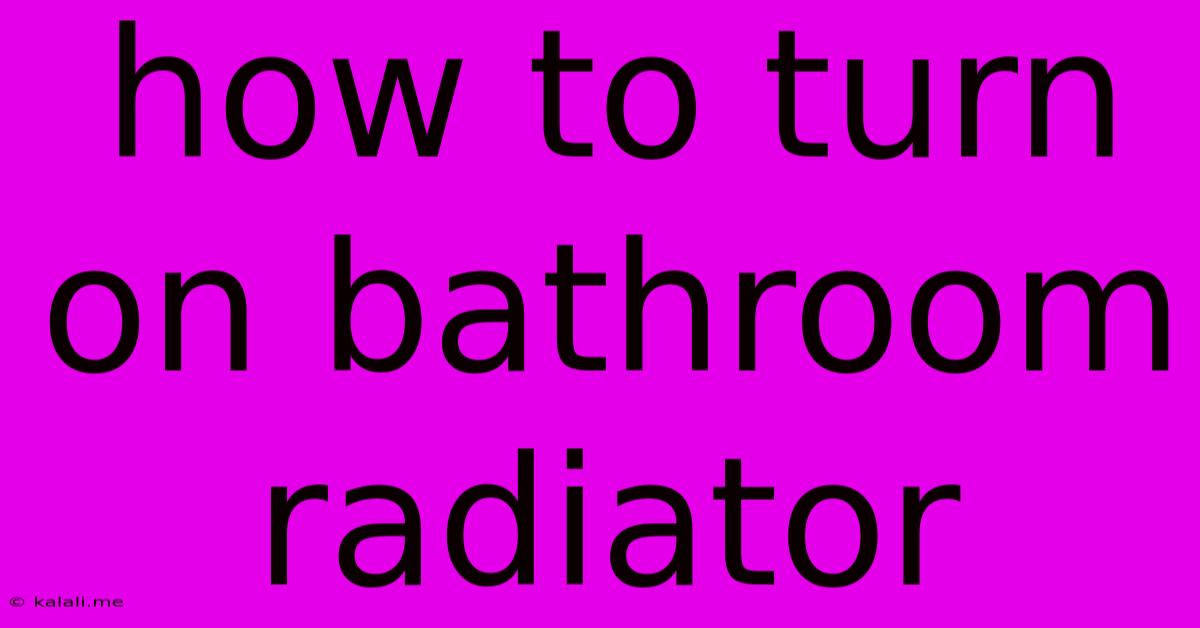How To Turn On Bathroom Radiator
Kalali
May 21, 2025 · 3 min read

Table of Contents
How to Turn On Your Bathroom Radiator: A Simple Guide
Are you shivering in your bathroom, wishing for some comforting warmth? This guide will walk you through the simple process of turning on your bathroom radiator, covering various types and troubleshooting common issues. Knowing how to operate your radiator efficiently contributes to a cozy home and potentially lowers your energy bills.
Understanding Your Radiator System
Before you start, it's crucial to identify the type of radiator you have. There are mainly two types:
- Manually Operated Radiators: These are the simplest type, usually equipped with a valve that you manually turn to control the water flow.
- Thermostatic Radiator Valves (TRVs): These valves have a dial or digital display that allows you to set a specific temperature. They automatically regulate the flow of hot water to maintain that temperature.
Turning On a Manually Operated Radiator
This process is straightforward:
- Locate the Valve: The valve is usually situated at one end of the radiator, often with a small handle or wheel.
- Turn the Valve: Turn the handle clockwise. You should feel some resistance as you turn it. The radiator should begin to heat up within a short time, depending on your central heating system. The extent of the turn might vary, so experiment and adjust as needed to achieve your desired heat level.
Turning On a Thermostatic Radiator Valve (TRV)
TRVs offer greater control over the temperature:
- Locate the Dial or Display: The dial or display will be on the valve itself.
- Set the Desired Temperature: Turn the dial clockwise to increase the temperature. The numbers usually correspond to the temperature in degrees Celsius or Fahrenheit. Start with a moderate setting and adjust as needed. Digital TRVs usually have buttons for easy adjustment.
- Observe the Radiator: The radiator will adjust its heat output based on your setting. The valve might initially let a lot of hot water through before regulating itself.
Troubleshooting Common Issues
Even with straightforward instructions, issues may still arise. Here are some troubleshooting tips:
- Radiator Not Heating Up:
- Check the Central Heating System: Ensure your central heating system is switched on and working properly. Check the boiler and thermostat.
- Bleeding the Radiator: Air trapped inside the radiator can prevent it from heating efficiently. Learn how to bleed your radiator (refer to your heating system's manual or consult a plumber).
- Blocked Valve: The valve might be clogged. You may need to contact a professional to clear the blockage.
- Radiator Too Hot:
- Adjust the Valve: If you're using a manual valve, simply turn it slightly counterclockwise.
- Lower the Thermostat Setting: If using a TRV, turn the dial counterclockwise to reduce the temperature setting.
Maximizing Radiator Efficiency
To ensure your bathroom stays warm and comfortable without excessively high energy consumption:
- Bleed Radiators Regularly: This ensures optimal heat distribution.
- Use Radiator Covers Strategically: They can help to reflect heat back into the room, improving efficiency.
- Don't Block Radiators: Keep furniture and curtains away from radiators to allow for proper heat circulation.
By following these simple steps and troubleshooting tips, you can easily turn on your bathroom radiator and enjoy a warm and comfortable bathroom. Remember to always consult a professional if you encounter persistent issues or are unsure about any aspect of your heating system.
Latest Posts
Latest Posts
-
Who Is The One Eyed Owl
May 21, 2025
-
My Cat Will Only Eat Dry Food
May 21, 2025
-
Can You Use Induction Cookware On A Gas Stove
May 21, 2025
-
Best Glue For Metal To Plastic
May 21, 2025
-
Are All Jinns Locked Up In Ramadan
May 21, 2025
Related Post
Thank you for visiting our website which covers about How To Turn On Bathroom Radiator . We hope the information provided has been useful to you. Feel free to contact us if you have any questions or need further assistance. See you next time and don't miss to bookmark.